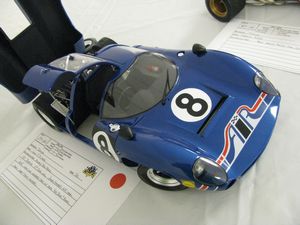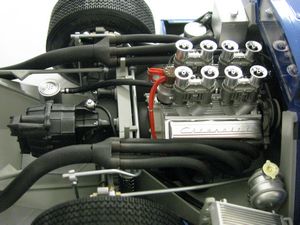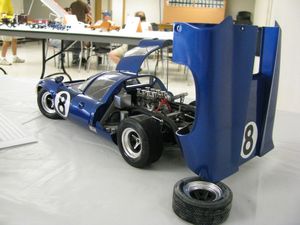















Lola T70 |
|---|

|
| Topic Navigation |
|---|
|
Wikipedia: Lola T70
Page Sections History Photographs Merchandise |
History
The following section is an excerpt from Wikipedia's Lola T70 page on 27 June 2017, text available via the Creative Commons Attribution-ShareAlike 3.0 Unported License.
The Lola T70 was developed by Lola Cars in 1965 in Great Britain for sports car racing. Lola built the chassis, which were typically powered by large American V8s.
The T70 was quite popular in the mid to late 1960s, with more than 100 examples being built in three versions: an open-roofed Mk II spyder, followed by a Mk III coupé, and finally a slightly updated Mk IIIB. The T70 was replaced in the Can-Am series by the lighter Lola T160.
Early success for the Lola T70 came when Walt Hansgen won the Monterey Grand Prix, at Laguna Seca Raceway, on 17 October 1965, driving John Mecom's Lola T70-Ford.
In 1966, the hot setup for the Can-Am was a T70 Chevrolet, winning five of six races during the year. John Surtees was the champion and Dan Gurney drove the only Ford powered car ever to win a Can-Am race. In 1967, no one could compete with the new M6 McLaren.
When the FIA changed the rules for sports car racing for the 1968 season, limiting engine size of prototypes to three liters, sportscars with up to five liter engines were allowed if at least fifty were made. This homologation rule allowed the popular yet outdated Ford GT40 and Lola T70s to continue racing. The Fords won Le Mans again in 1968 and 1969, while the T70's only big endurance win was a one-two finish in the 1969 24 Hours of Daytona behind the Sunoco Lola T70-Chevrolet of Mark Donohue and Chuck Parsons. When the minimum number was lowered to twenty five for 1969, the more modern Porsche 917 and Ferrari 512 were homologated and outran the older Lolas and Fords.
Chevrolet powered coupes tended to suffer reliability problems when racing in Europe, in part due to the grade of fuel allowed. When forced to run on commercially available "pump fuel", with a lower octane rating than the "Avgas" permitted under American rules, engine failures were common. In modern historic racing, these engines show much improved reliability due to parts unavailable in the 1960s and better fuel quality than the historically poor petrol supplied by the ACO.
An Aston Martin powered coupe was entered by Lola for Le Mans in 1967. Even with drivers such as John Surtees, it was a disaster. The Aston Martin V8 engine failed after short runs, attributed to inadequate developmental funds.
During the filming of Steve McQueen's Le Mans, Lola chassis were disguised as the Porsche 917 and Ferrari 512s that crashed in the film. It is claimed chassis T76/141 originally campaigned by Ulf Norinder and Jo Bonnier was used for the wrecked Gulf Porsche. A T70 coupe also appears as a car of the future in George Lucas' first commercial film, THX 1138.
In 2005, Lola Cars announced a revival of the T70 MkIIIb in "an authentic and limited continuation series" of the original racer. It is unclear if any were ever produced before Lola Cars went defunct in 2012.
Replicas
A UK company, Gardner Douglas produces the T70 Spyder with styling inspired by the Lola car, and using an tubular spaceframe chassis with GRP panelling.
British Company Broadley Automotive http://broadleyautomotive.co.uk makes T70 Mk3B replicas using original moulds and drawings. So authentic they have been granted FIA Historic Technical Passports (HTPs), a number of these Broadley T76s can be seen racing in the FIA Masters Historic Sportscar Championship, where they regularly compete alongside original T70s, Ferrari 512s and Porsche 917s for outright victories.
A US company, "Race Car Replicas" produces an authentic looking replica of both the MkII and MkIIIB T70 using an aluminium monocoque chassis.
A South African Company, "Universal Products" produces a tubular spaceframe-chassis version, clad in aluminium, of the T70 MkIIIB.
Swiss car manufacturer Sbarro produced 13 T70 MKIII.
 |
American International Racers MkIII 1:12 Scale, AIR logo & number decals hand cut Photo ©2012 Bill Crittenden 2012 Summer NNL hosted by 
View photo of American International Racers Lola T70 MkIII 1:12 Scale Model - 3.7MB |
 |
American International Racers MkIII 1:12 Scale, AIR logo & number decals hand cut Photo ©2012 Bill Crittenden 2012 Summer NNL hosted by 
View photo of American International Racers Lola T70 MkIII 1:12 Scale Model - 3.9MB |
 |
American International Racers MkIII 1:12 Scale, AIR logo & number decals hand cut Photo ©2012 Bill Crittenden 2012 Summer NNL hosted by 
View photo of American International Racers Lola T70 MkIII 1:12 Scale Model - 3.4MB |
| Type & Item # | Name | Details |
|---|---|---|
| Die Cast - GMP G1801511 | Dan Gurney Lola T70 Mk.3B | 1:18 scale, dark blue #36, Production: 1,002 |
| Die Cast - GMP G1801512 | Hulme T70C Lola | 1:18 scale, white w/green stripe #36, Production: 1,000 |
